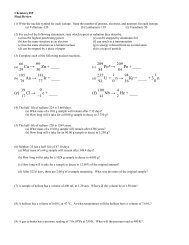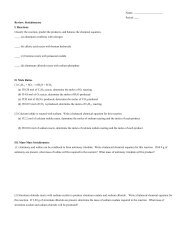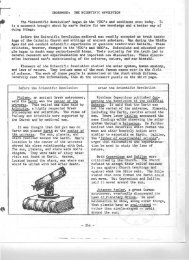Am His AP Review.pdf - yourhomework.com Home Page
Am His AP Review.pdf - yourhomework.com Home Page
Am His AP Review.pdf - yourhomework.com Home Page
You also want an ePaper? Increase the reach of your titles
YUMPU automatically turns print PDFs into web optimized ePapers that Google loves.
- Some reformers also tacked Indian affairs, as Indians were still being treated as minorities expected toassimilate [e/t the Dawes Act had failed in ac<strong>com</strong>plishing that goal]. Citizenship was finally granted toIndians in 1924, and the Bureau of Indian Affairs was reorganized [not great effect though].- Women also had achieved more a share in politics w/the Nineteenth <strong>Am</strong>endment (1920), which gavethem suffrage – nevertheless, women were mainly kept out of power with the exception of organizationsthey founded themselves [League of Women Votes, National Woman’s Party].*Social Trends*- Some noteworthy characteristics are as follows… Urbanization – With consumerism and modernization there came a migration to the cities,where manufacturing jobs were more readily available. Great Migration and Discrimination – African <strong>Am</strong>ericans, especially, moved into the cities,where they were forced to squeeze into tiny sectors due to discrimination. This led tomovements glorifying black racial pride/independence – like the UNIA led by Marcus Garvey,which was influential in the early 1920s before it was shut down for anarchism. Mexican/Puerto Rican Immigration – Mexican immigrants crowded into districts in theSouthwest, and PR’s moved mainly to NYC. In both places, they created their own<strong>com</strong>munities that maintained their cultures. Suburbia – The car made <strong>Am</strong>ericans take to the roads, and to the suburbs, which increasinglyresisted annexation to the cities. Increasing Life Expectancy/Decreasing Birth Rate – People lived longer due to better nutritionand sanitation, and they had fewer kids. Pensions – As mentioned earlier, old age pensions were an issue during the twenties due topeople living longer. Though some felt people should just save in their youth, reformers beganto win out on the state level. New Appliances – There were fewer servants, so women managed the household on their ownwith the aid of the new electrical appliances. Employment for Women – Women continued to go into the work force, but sex segregationcontinued. More minority women worked than white women, as their husbands were more<strong>com</strong>monly unemployed or in low paying jobs. New Values – Them shockin’ young people! Smoking, drinking, swearing, and openness aboutsex began to be<strong>com</strong>e fashionable in the cities. Dear me. Then of course there was theflapper, and the new more assertive woman.- Out of all this, perhaps the most important thing to remember: The movement towards the suburbs andcities [as well as the radio] helped the new mass culture spread. With that…*Cultural Trends: Popular and Otherwise*- The 1920s witnessed the birth of a new mass culture and more leisure time for <strong>Am</strong>ericans. New forms ofentertainment and culture included: Movies – Silent film, then sound with The Jazz Singer. Most movies were escapist fantasies,and people flocked to see the hot new movie stars like Clara Bow, Rudolph Valentino, GretaGarbo – okay, this is NOT supposed to be about that! Sports – With mass culture came a loss of individuality, so people looked to sports figures asrepresentatives of the triumph of the unique individual. “Lucky Lindy” is another example of thistype of hero-worship. Prohibition or Lack Thereof – People still drank in speakeasies and such, and all theEighteenth <strong>Am</strong>endment did was give gangsters like Al Capone tremendous power.- As for literature and the arts… The Lost Generation – Gotta love F. Scott Fitzgerald [my favorite writer, not that you care]and his cronies like Hemingway, etc. Faced w/materialism and conformity, many writers wentabroad during the 1920s and wrote about <strong>Am</strong>erica from afar. Others stayed, but still spokeabout the same themes: alienation, hypocrisy, conformity, and so on. Harlem Renaissance – Blacks flocked to Harlem, where they established a vibrant artistic<strong>com</strong>munity that celebrated black culture. A big issue for intellectuals in the HR was identity. Jazz – A major part of the Harlem Renaissance was Jazz, which owed a lot to black cultureand music. Jazz was a huge hit in the cities, and helped the recording industry greatly. Innovative Art/Music – The twenties were very creative, and many artists attempted newstyles, like Georgia O’Keefe in painting, Aaron Copland and George Gershwin in music,and Frank Lloyd Wright and his “prairie-style houses” in architecture.60
















